
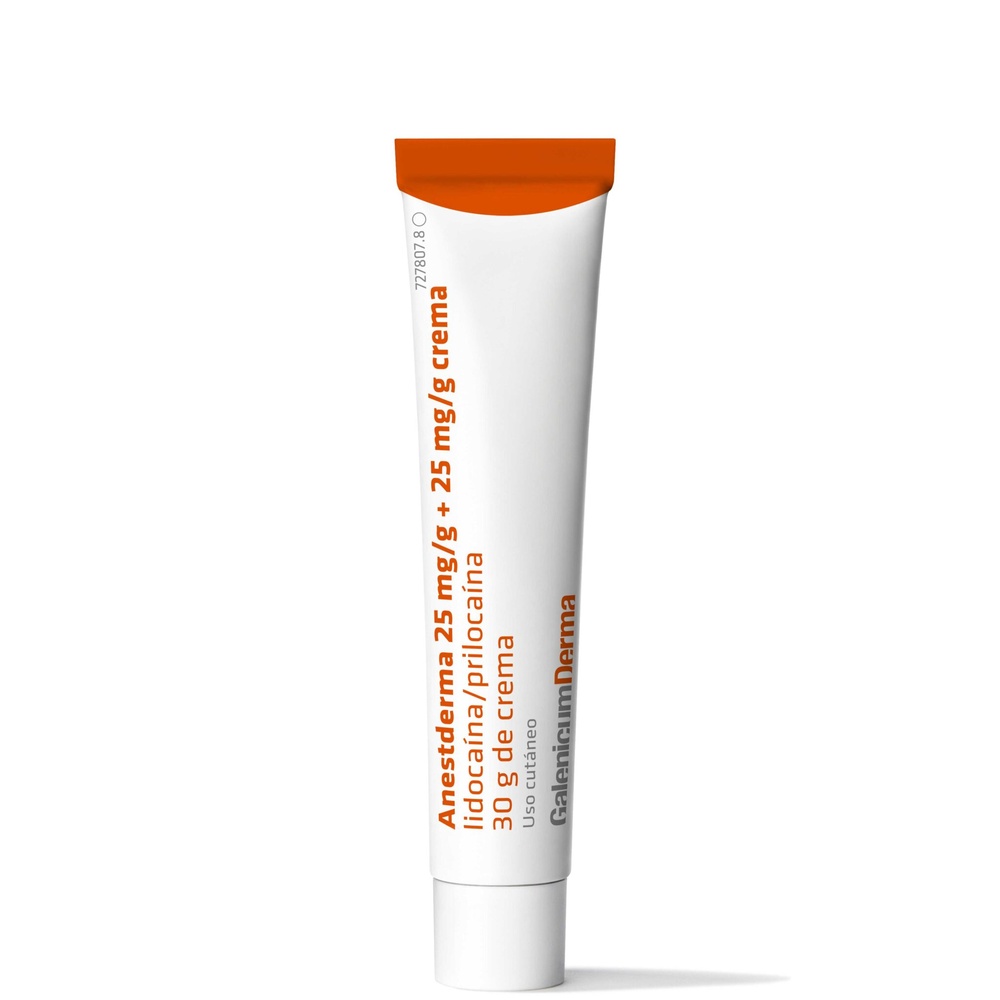
ANESTDERMA 25 mg/g + 25 mg/g CREAM

Ask a doctor about a prescription for ANESTDERMA 25 mg/g + 25 mg/g CREAM

How to use ANESTDERMA 25 mg/g + 25 mg/g CREAM
Introduction
Package Leaflet: Information for the Patient
Anestderma 25 mg/g + 25 mg/g cream
Lidocaine/Prilocaine
Read all of this leaflet carefully before you start using this medicine because it contains important information for you.
- Keep this leaflet, you may need to read it again.
- If you have any further questions, ask your doctor, pharmacist, or nurse.
- This medicine has been prescribed for you only. Do not pass it on to others. It may harm them, even if their signs of illness are the same as yours.
- If you get any side effects, talk to your doctor or pharmacist. This includes any possible side effects not listed in this leaflet. See section 4.
Contents of the pack
- What is Anestderma and what is it used for
- What you need to know before you use Anestderma
- How to use Anestderma
- Possible side effects
5 Storage of Anestderma
- Contents of the pack and further information
1. What is Anestderma and what is it used for
Anestderma contains two active substances called lidocaine and prilocaine. They belong to a group of medicines called local anesthetics.
Anestderma works by numbing the surface of the skin temporarily. It is applied to the skin before certain medical procedures. It helps to stop pain in the skin; however, you may still feel sensations such as pressure and touch.
Adults, adolescents, and children
It can be used to numb the skin before:
- Needle puncture (e.g., if you are going to have an injection or have a blood test).
- Minor skin surgery.
Adults and adolescents
It can also be used:
- To numb the genitals before:
- Having an injection.
- Medical procedures such as removal of warts.
The use of Anestderma on the genitals should be supervised by a doctor or nurse.
Adults
It can also be used to numb the skin before:
- Cleaning or removing damaged skin from leg ulcers.
2. What you need to know before you use Anestderma
Do not use Anestderma:
- if you are allergic to lidocaine or prilocaine, or other similar local anesthetics or to any of the other ingredients of this medicine (listed in section 6).
Warnings and precautions
Consult your doctor or pharmacist before starting to use Anestderma:
- if you or your child have a rare inherited blood disorder called “glucose-6-phosphate dehydrogenase deficiency”.
- if you or your child have a condition affecting the levels of a pigment in the blood called “methemoglobinemia”.
- do not use Anestderma on areas with skin rash, cuts, abrasions, or open wounds, except for leg ulcers. If you have any of these problems, consult your doctor or pharmacist before using the cream.
- if you or your child have a skin condition with itching called “atopic dermatitis”, a shorter application time may be sufficient. Application times of more than 30 minutes may increase the risk of local skin reactions (see also section 4 “Possible side effects”).
- if you are being treated with medicines for heart rhythm disorders (class III antiarrhythmics, such as amiodarone). In this case, your doctor will monitor your heart function.
Due to the potentially greater absorption over recently shaved skin, it is important to follow the recommended dose, skin surface, and application time.
Avoid contact of Anestderma with the eyes, as it may cause irritation and chemical burns to the eyes. If it accidentally enters your eye, rinse it immediately with warm water or saline solution (sodium chloride solution). Be careful not to apply anything to the eye until sensitivity returns.
Children should be carefully supervised when using Anestderma on any part of their body to avoid Anestderma coming into contact with the eyes.
Anestderma should not be applied to damaged eardrums.
When using Anestderma before being vaccinated with live vaccines (e.g., tuberculosis vaccine), revisit your doctor or nurse after the required follow-up period for the vaccination result.
Children and adolescents
In infants and newborns under 3 months, “methemoglobinemia” is often observed, a transient and clinically insignificant increase in blood pigment levels, up to 12 hours after application of Anestderma.
Clinical studies could not confirm the efficacy of Anestderma when blood is drawn from the heel of newborns or to provide adequate analgesia during circumcision.
Anestderma should not be applied to the genital skin (e.g., on the penis) or genital mucosa (e.g., in the vagina) of children (under 12 years) because there is insufficient data on the absorption of the active substances.
Anestderma should not be used in children under 12 months of age who are simultaneously receiving treatment with other medicines that affect the levels of the blood pigment “methemoglobin” (e.g., sulfonamides, see also section 2, Use of Anestderma with other medicines).
Anestderma should not be used in premature newborns.
Use of Anestderma with other medicines
Tell your doctor or pharmacist if you are using, have recently used, or might use any other medicines, including those obtained without a prescription and herbal medicines. This is because Anestderma may affect the way other medicines work and other medicines may affect the way Anestderma works.
In particular, inform your doctor or pharmacist if you or your child have recently used or are being treated with any of the following medicines:
- Medicines used to treat infections called “sulfonamides” and nitrofurantoin.
- Medicines used to treat epilepsy, called phenytoin and phenobarbital.
- Other local anesthetics.
- Medicines for heart rhythm disorders, such as amiodarone.
- Cimetidine or beta-blockers, which may increase lidocaine levels in the blood. This interaction is not clinically significant in short-term treatment with Anestderma at the recommended doses.
Pregnancy, breastfeeding, and fertility
If you are pregnant or breastfeeding, think you may be pregnant, or are planning to have a baby, ask your doctor or pharmacist for advice before using this medicine.
Occasional use of Anestderma during pregnancy is unlikely to have any adverse effect on the fetus.
The active substances of Anestderma (lidocaine and prilocaine) are excreted in breast milk. However, the amount is so small that it is generally not a risk to the child.
Animal studies have shown that there are no effects on male or female fertility.
Driving and using machines
Anestderma does not affect the ability to drive and use machines, or the effect is negligible, when used at the recommended doses.
Anestderma containsmacrogolglycerol hydroxystearate.
This medicine may cause skin reactions because it contains macrogolglycerol hydroxystearate.
3. How to use Anestderma
Follow exactly the instructions for administration of this medicine given by your doctor, pharmacist, or nurse. If you are unsure, consult your doctor, pharmacist, or nurse again.
Use ofAnestderma
- The place where you apply the cream, the amount you should use, and the time it should stay on will depend on what it is used for.
- Your doctor, pharmacist, or nurse will apply the cream or teach you how to do it yourself.
- When Anestderma is used on the genitals, a doctor or nurse should supervise its use.
Do not useAnestdermaon the following areas:
- Cuts, abrasions, or open wounds, except for leg ulcers.
- Areas with skin rash or eczema.
- On or near the eyes.
- Inside the nose, ear, or mouth.
- On the anus.
- On the genitals of children.
People who frequently apply or remove the cream should take care to avoid contact to prevent the development of hypersensitivity.
The protective membrane of the tube is pierced by pressing the cap onto it.
Use on the skin before minor procedures (such as needle puncture or minor skin procedures):
- Apply a thick layer of cream to the skin. Your doctor, pharmacist, or nurse will tell you where to apply it.
- Cover the cream with a dressing [transparent plastic]. This is removed just before starting the procedure. If you apply the cream yourself, make sure your doctor, pharmacist, or nurse provides you with the dressings.
- The usual dose for adults and adolescents over 12 years is 2 g (grams).
- In adults and adolescents over 12 years, apply the cream at least 60 minutes before the procedure (unless the cream is to be used on the genitals). However, do not apply it more than 5 hours before.
- In children, the amount of Anestderma used and the application time depend on their age. Your doctor, nurse, or pharmacist will tell you how much to use and when to apply it.
When applying the cream yourself, it is very important to follow the following instructions:
- Squeeze the tube to apply the necessary amount of cream to the skin where the procedure will be performed (e.g., where the needle will be inserted).
A line of cream about 3.5 cm from the 30 g tube is equivalent to 1 g of cream. Half of the 5 g tube corresponds to approximately 2 g of Anestderma.
Do not spread the cream.
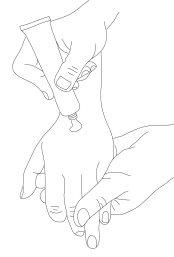
- Remove the dressing covers.
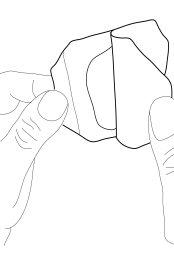
- Place it carefully over the cream mound. Do not spread the cream under the dressing.
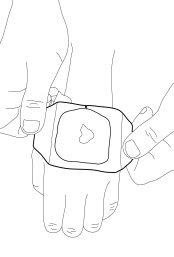
- Remove the paper backing. Smooth the edges of the dressing carefully. Then leave it in place for at least 60 minutes if the skin has not been damaged. The cream should not be left in place for more than 60 minutes in children under 3 months or for more than 30 minutes in children with atopic dermatitis. If the cream is used on the genitals or on ulcers, shorter application times may be used, as described below.
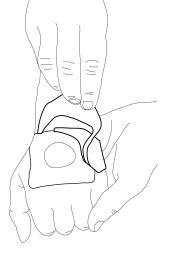
- Your doctor or nurse will remove the dressing and remove the cream just before performing the medical procedure (e.g., just before inserting the needle).

Use on extensive areas of freshly shaved skin before outpatient procedures (such as hair removal techniques):
The usual dose is 1 g of cream per 10 cm² (10 square centimeters) of skin surface, applied under a dressing for 1 to 5 hours. Anestderma should not be used on a freshly shaved skin area larger than 600 cm² (600 square centimeters, e.g., 30 cm by 20 cm). The maximum dose is 60 g.
Use on the skin before hospital procedures (such as skin grafts) that require deeper skin anesthesia
- Anestderma can be used in this way in adults and adolescents over 12 years.
- The usual dose is 1.5 g to 2 g of cream per 10 cm² (10 square centimeters) of skin surface.
- The cream is applied under an occlusive dressing for 2 to 5 hours.
Use on the skin to remove warty lesions called “molluscum”
- Anestderma can be used in children and adolescents with atopic dermatitis.
- The usual dose depends on the child's age and is used for 30 to 60 minutes (30 minutes if the patient has atopic dermatitis). Your doctor, nurse, or pharmacist will tell you how much cream to apply.
Use on the genital skin before injecting local anesthetics
- Anestderma can be used in this way only in adults and adolescents over 12 years.
- The usual dose is 1 g of cream (1 g to 2 g on the female genital skin) per 10 cm² (10 square centimeters) of skin surface.
- The cream is applied under an occlusive dressing. This is left on for 15 minutes on the male genital skin and for 60 minutes on the female genital skin.
Use on the genitals before minor skin surgery (removal of warts)
Anestderma can be used in this way only in adults and adolescents over 12 years. The usual dose is 5 g to 10 g of cream for 10 minutes. No occlusive dressing is used. The medical procedure should be started immediately.
Use on leg ulcers before cleaning or removing damaged skin
- The usual dose is 1 g to 2 g per 10 cm² (10 square centimeters) of skin surface, up to a maximum of 10 g.
- The cream is applied under an occlusive dressing, e.g., a transparent plastic. This is left on for 30 to 60 minutes before cleaning the ulcer. Remove the cream with a cotton swab and start cleaning without delay.
- Anestderma can be used before cleaning leg ulcers up to 15 times in a period of 1-2 months.
- The Anestderma tube is for single use when used on leg ulcers: The tube with any remaining contents should be discarded each time after treating a patient.
If you use more Anestderma than you should
If you use more Anestderma than your doctor, pharmacist, or nurse has told you, contact them immediately, even if you do not have any symptoms.
The following are symptoms if you use too much Anestderma. It is unlikely that these symptoms will occur if you follow the recommended use of Anestderma.
- Dizziness or lightheadedness.
- Numbness or tingling around the mouth and tongue.
- Altered taste.
- Blurred vision.
- Ringing in the ears.
- There is also a risk of “acute methemoglobinemia” (a problem with blood pigment levels). This risk is higher when taking certain medicines at the same time. If this happens, the skin takes on a bluish-gray color due to lack of oxygen.
In severe cases of overdose, symptoms may include seizures, low blood pressure, slow breathing, cessation of breathing, and alteration of heart rhythm. These effects can be potentially fatal.
In case of overdose or accidental ingestion, consult the Toxicology Information Service. Phone 91 562 04 20.
If you have any doubts about the use of this medicine, ask your doctor, pharmacist, or nurse.
4. Possible Adverse Effects
Like all medicines, this medicine can cause adverse effects, although not all people suffer from them.
Contact your doctor or pharmacist if any of the following adverse effects cause you discomfort or do not seem to disappear. Inform your doctor of anything else that makes you feel unwell while using Anestderma.
A mild reaction (pallor or redness of the skin, slight swelling, initial burning or itching) may appear in the area where Anestderma is applied. These are normal reactions to the cream and anesthetics and will disappear shortly without the need for any action.
If you experience any unpleasant or unusual effect while using Anestderma, stop using it and consult your doctor or pharmacist as soon as possible.
Frequent(may affect up to 1 in 10 people)
- Local transient skin reactions (pallor, redness, swelling) in the application area during treatment on the skin, genital mucosa, or leg ulcers.
- A mild initial sensation of burning, itching, or heat in the application area during treatment on the genital mucosa or leg ulcers.
Uncommon(may affect up to 1 in 100 people)
- A mild initial sensation of burning, itching, or heat in the treated area during treatment on the skin.
- Numbness (tingling) in the application area during treatment on the genital mucosa.
- Skin irritation in the application area during treatment of leg ulcers.
Rare(may affect up to 1 in 1,000 people)
- Allergic reactions that, in rare cases, can lead to anaphylactic shock (skin rash, swelling, fever, difficulty breathing, and fainting) during treatment on the skin, genital mucosa, or leg ulcers.
- Metahemoglobinemia (blood disorder) during treatment of the skin.
- Small pinpoint bleeding in the treated area (particularly in children with eczema after long periods of application), during treatment on the skin.
- Eye irritation if Anestderma accidentally comes into contact with the eyes during treatment on the skin.
Frequency Not Known(cannot be estimated from the available data)
- Chemical burns to the eyes if Anestderma accidentally comes into contact with them during treatment.
Other Adverse Effects in Children
Metahemoglobinemia, a blood disorder that is usually observed more frequently in newborns and infants from 0 to 12 months, often associated with overdose.
Reporting of Adverse Effects
If you experience any type of adverse effect, consult your doctor or pharmacist, even if it is a possible adverse effect that is not listed in this leaflet. You can also report them directly through the Spanish Pharmacovigilance System for Human Use Medicines: https://www.notificaram.es/. By reporting adverse effects, you can contribute to providing more information on the safety of this medicine.
5. Storage of Anestderma
Store below 30 °C. Do not refrigerate or freeze.
After the first opening, use within 6 months.
Keep this medicine out of the sight and reach of children.
Do not use this medicine after the expiration date that appears on the packaging and on the tube after CAD. The expiration date is the last day of the month indicated.
Medicines should not be thrown away through wastewater or household waste. Deposit the packaging and medicines you no longer need at the SIGRE Point in the pharmacy. In case of doubt, ask your pharmacist how to dispose of the packaging and medicines you no longer need. This way, you will help protect the environment.
6. Package Contents and Additional Information
Composition ofAnestderma
- The active ingredients are: lidocaine and prilocaine. Each gram of cream contains 25 mg of lidocaine and 25 mg of prilocaine.
- The other components are macrogolglycerol hydroxystearate, carbomer 974P, sodium hydroxide, and purified water.
Appearance of the Product and Package Contents
Anestderma is a soft white cream. It is presented in flexible aluminum tubes of 5 g and 30 g, internally coated with an epoxy phenolic lacquer.
Package sizes:
1 tube of 30g
1 tube of 5g
1 tube of 5g with 2 dressings
1 tube of 5g with 3 dressings
5 tubes of 5g
5 tubes of 5g with 12 dressings
Only some package sizes may be marketed.
Marketing Authorization Holder and Manufacturer
Marketing Authorization Holder
GALENICUM DERMA, S.L.U.
National Highway 1, Km 36
28750 San Agustín del Guadalix (Madrid)
Spain
Manufacturer
Rafarm SA,
Thesi Pousi-Xatzi,
Agiou Louka,
Paiania, Attiki-19002,
P.O. Box 37, Greece.
or
Qualimetrix SA
579 Mesogeion avenue, Agia Paraskevi,
Athens, 15343, Greece
This medicine is authorized in the Member States of the European Economic Area under the following names:
Estonia: Nulbia
Spain: Anestderma 25mg/g + 25 mg/g cream
Date of the Last Revision of this Leaflet:November 2024
Detailed and updated information on this medicine is available on the website of the Spanish Agency for Medicines and Health Products (AEMPS) http://www.aemps.gob.es/.

How much does ANESTDERMA 25 mg/g + 25 mg/g CREAM cost in Spain ( 2026)?
The average price of ANESTDERMA 25 mg/g + 25 mg/g CREAM in January, 2026 is around 10.02 EUR. Prices may vary depending on the region, pharmacy, and whether a prescription is required. Always check with a local pharmacy or online source for the most accurate information.
- Country of registration
- Average pharmacy price10.02 EUR
- Active substance
- Prescription requiredYes
- Manufacturer
- This information is for reference only and does not constitute medical advice. Always consult a licensed doctor before taking any medication. Oladoctor is not responsible for medical decisions based on this content.
- Alternatives to ANESTDERMA 25 mg/g + 25 mg/g CREAMDosage form: CREAM, 25 mg/g + 25 mg/gActive substance: combinationsManufacturer: Glenmark Arzneimittel GmbhPrescription requiredDosage form: CREAM, Lidocaine 25 mg/g + Prilocaine 25 mg/gActive substance: combinationsManufacturer: Mesoestetic Pharma Group S.L.Prescription requiredDosage form: CREAM, 25 mg lidocaine; 25 mg prilocaine/ gActive substance: combinationsManufacturer: Aspen Pharma Trading LimitedPrescription required
Alternatives to ANESTDERMA 25 mg/g + 25 mg/g CREAM in other countries
The best alternatives with the same active ingredient and therapeutic effect.
Alternative to ANESTDERMA 25 mg/g + 25 mg/g CREAM in Poland
Alternative to ANESTDERMA 25 mg/g + 25 mg/g CREAM in Ukraine
Online doctors for ANESTDERMA 25 mg/g + 25 mg/g CREAM
Discuss dosage, side effects, interactions, contraindications, and prescription renewal for ANESTDERMA 25 mg/g + 25 mg/g CREAM – subject to medical assessment and local rules.














